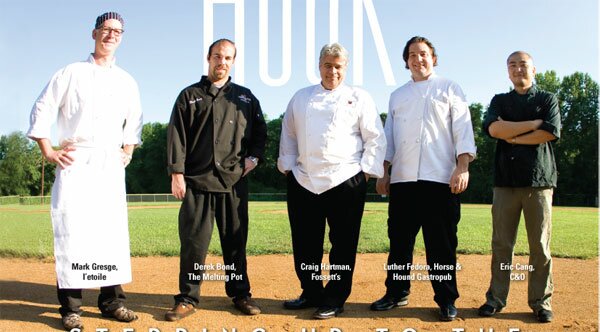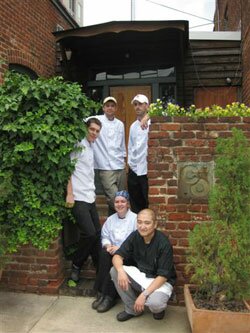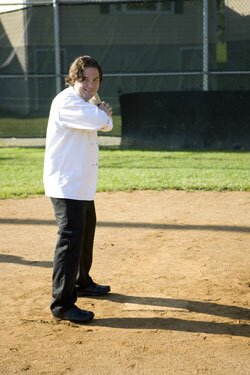COVER- Stepping up to the plate: Local chefs take on the challenge of Restaurant Week

The chefs of Restaurant Week
PHOTO BY WILL WALKER

Mark Gresge
PHOTO BY WILL WALKER
Mark Gresge
l'étoile
Mark Gresge has been proudly in in business as owner and chef at l'étoile since 1999. But as recently as 1993, his career path led not to a bistro on West Main but up the ladder of a multinational corporation whose work can be described in just one word: plastics.
"I was an engineer with Klöckner Pentaplast," says Gresge, "I was a kind of efficiency expert, trying to figure out how to streamline their processes."
At least, that was the job description.
"In all honesty," says Gresge, "I was much more like Smithers on The Simpsons, an assistant to the boss."
So when the opportunity arose to trade in pencil pushing for home cooking, he made the leap to West Main.
"Originally, my wife was running the 1817, where the Dinsmore House is now," says Gresge, speaking of the bed and breakfast just east of the Corner, "and the idea was to open up a little luncheonette and serve light fare to old ladies."
But soon the pair's ambitions and operations grew.
"We really wanted to serve dinner," says Gresge, "and we really wanted to create an atmosphere where we created a real dining experience for people, from the food, to the lighting, to the service, everything."
Hence, l'étoile was born, and has been serving fine fare for the last three years. Not that Gresge has lost his engineering background altogether.
"Engineering is a lot of linear thinking, a + b = c," says Gresge, "and in some ways preparing a dish is similar. You have a starch, a vegetable, and a protein and you try to get those to work together."
L'étoile's Restaurant Week Shrimp and Grits
Serves four
Ingredients
Grits:
4 to 5 cups vegetable stock
Salt
1 cup yellow stone ground grits
1 cup grated white Cheddar
Freshly ground black pepper
3 green onions, thinly sliced, for garnish
Sauteed Shrimp:
1/2 pound thick double-smoked cut bacon, cut into lardons
2 tablespoons pure olive oil
20 large (21 to 24 count) shrimp, shelled and deveined
3 cloves garlic, finely chopped
Salt and freshly ground black pepper
1 cup diced onion, ½ cup diced carrot, ½ cup diced celery
1 cup cherry tomatoes, halved
For the grits:
Bring 4 cups of the water and 2 teaspoons of salt to a boil in a medium saucepan over high heat. Slowly whisk in the grits and bring to a boil. Reduce the heat to medium and continue cooking until the grits are soft and have lost their gritty texture, whisking every few minutes, 15 to 20 minutes. If the mixture becomes too thick, add remaining water and continue cooking until absorbed. Add the cheese and whisk until smooth; season with salt and pepper.
For the shrimp:
Place bacon in a medium pan over medium heat and cook until golden brown and crisp and the fat has rendered. Remove bacon with a slotted spoon to a plate lined with paper towels.
Remove all but 2 tablespoons of the bacon fat from the pan and place back on the heat. Add the olive oil and increase the heat to high. Add onion, carrot, and celery. Then add tomatoes. Season the shrimp with salt and pepper, and add to the pan with the garlic. Sautée until golden brown on both sides and just cooked through, 1 to 2 minutes per side. Remove shrimp to a plate. Reserve the garlic oil to drizzle over the finished dish.
Divide the grits among 4 bowls and top each with 5 shrimp. Drizzle the top with some of the bacon-garlic oil (that the shrimp were sauteed in) and sprinkle with some of the green onion.

The men and women of the C&O
PHOTO BY WILL WALKER
Dave Simpson, Eric Cang, Nathan and Rachel Kambik, Brian Colbert and Joel Myers
C&O Restaurant
How do you keep positive reviews flowing– and customers flocking– for three decades? The answer, says C&O owner Dave Simpson, is consistency coupled with a willingness to evolve. Case in point: in the last three months, with the departure of C&O's head chef, who took over sister restaurant Bel Rio, Simpson decided to forego traditional kitchen hierarchy of a head chef and his or her staff and instead replaced it with a cooking team of highly trained chefs.
"Some would argue that there has to be someone who is ultimately responsible," says Simpson. "I believe we should all be responsible in equal measures."
Making that kind of change eliminates ego issues, he says, and makes for a "more wholesome environment, makes people more genuine with each other." Simpson, who took over the restaurant in 1981, says the current kitchen team of Eric Cang, husband and wife Nathan and Rachel Kambik, Brian Colbert and Joel Myers have made the concept work.
"Eric's been there the longest," Simpson says, adding that after four years as sous chef, Cang "could have demanded to be head chef. To his great credit, he didn't."
Another recent evolution? Focus on local foods. "We're ahead of the curve there," says Simpson, who says C&O's chefs are making their own cheeses and that the meat C&O serves is from local farms.
As for consistency, Simpson says, the trick is to give customers "flagship" dishes they can always count on along with new menu additions for variety. For restaurant week, Simpson says, he and his staff included steak chinois and the vegetable soup, longtime C&O staples. "The idea is to get new people into the restaurant," he says, "to show them what we're all about."
C&O's Restaurant Week Peach and Blueberry cobbler
Equipment: One half shallow hotel pans
½ pound of butter
2 pints of blue berries
4 quarts of peaches, peeled and pared
1 cup of sugar
¼ cup cornstarch
¼ peach Schnapps
1 teaspoon of salt
Melt butter in stock pot, add all the ingredients above and stir over medium heat until warmed and coated. Place in buttered half hotel pan.
Cover with crust recipe, and bake for 35 minutes at 375 until golden.
Crust recipe for half hotel pan
5 cups of flour
1 cup of sugar
¾ pound of butter
2 ¾ cups of heavy cream, chilled
Glaze
2 tablespoons heavy cream
1 egg yolk
¼ cup of sugar
Combine flour, sugar and salt. Rub in cold butter or pulse in robo cutter to resemble cracked corn. Transfer to mixing bowl. Mix in heavy cream until the dough holds together. Do not over work the dough. Knead the dough on a floured surface. And roll to a thickness of ¾ inch. Place cooled peach and blueberry mixture and brush the tops with a mixture of 1 egg yolks and 2 TBLS of heavy cream. Sprinkle the top with ¼ cup of sugar before baking. Bake for 40 minutes

Luther Fedora
PHOTO BY WILL WALKER
Luther Fedora
Horse & Hound Gastropub
Some people figure out what they want to do with their lives at an early age. And some figure out at a very early age.
"I made microwave scrambled eggs when I was three, and then it turned into Ramen noodles when I was four. Then I learned how to cook 'cajun' when I was five," recalls chef Luther Fedora, who co-owns the Horse and Hound with his wife, pastry chef Brooke Fedora. "My family loved it!"
Despite that early display of culinary ability, Fedora double majored in political science and business management at NC State and was on track to be a lawyer or stockbroker when a friend questioned why he wasn't following his passion: cooking.
That nudge was all the reminder he needed, and he soon enrolled in the Culinary Institute of America, where he met then-future wife. The two dated first, then were friends for several years as Luther worked in London and France and Brooke remained in Manhattan. Eventually, he says, their love was rekindled and they each decided they'd had enough of big city "craziness."
They relocated to Charlottesville in October 2003, working for various other restaurants before opening the Gastropub in 2007.
So what's up with that name?
The Horse & Hound part, Fedora says, reflects the restaurant's British and Virginia hunt country influence, while the word Gastropub should clue customers in a bit further. "Gastronomy is study of food," Fedora explains. The "pub" suggests a relaxed atmosphere. Altogether, Fedora says, "it means, awesome booze, awesome food, inexpensive price. That's what we try and do."
Horse & Hound's Restaurant Week Blueberry Sour Cream Crème Brûlée
2 cups Heavy Cream
1 cup sour cream
3/4 cup sugar
Zest of 1 lemon
8 egg yolks
1 pint of blueberries
Preheat the oven to 325 degrees.
Place the cream into a medium saucepan set over medium-high heat and bring to a boil.
In a medium bowl, whisk together 3/4 cup sugar, lemon zest, sour cream and the egg yolks until well blended and it just starts to lighten in color.
Add the cream a little at a time, stirring continually.
Put blueberries (about 15 per dish) into 8 (7 to 8-ounce) ramekins.
Pour the egg and cream mix over the blueberries.
Place the ramekins into a large cake pan or roasting pan. Pour enough hot water into the pan to come halfway up the sides of the ramekins.
Bake just until the crème brulee is set, but still trembling in the center, approximately 40 to 45 minutes. Remove the ramekins from the roasting pan and refrigerate for at least two hours and up to three days.
Divide 1/2 cup sugar equally among the eight dishes and spread evenly on top.
Using a torch, melt the sugar and form a crispy top. Allow the crème brulée to sit for at least five minutes before serving.

Craig Hartman
PHOTO BY WILL WALKER
Craig Hartman
Fossett's at Keswick Hall
Craig Hartman comes from a line of medical doctors, but he knew early on he wouldn't be following in his physician father's and grandfather's footsteps.
"They worked so hard, had a lot of stress," says Hartman, who instead found career inspiration in his grandmother, who owned and operated hotels in Ocean City, Maryland, where Hartman– a Pennsylvania native– spent his summers.
"I used to wake up in the morning to beautiful buffets," he recalls. He'd help pick the fresh produce from a truck that traveled the beach, and his first job at age 8 or 9 was fileting fish. "I got paid a quarter per fish," he laughs.
So convinced was Hartman of his career choice early on that he chose to attend a vocational high school ("to the chagrin of my family," he says) then attended the Culinary Institute of America.
By age 21, he was head chef of the country club at North Carolina's exclusive Pinehurst Resort– and that was just the beginning of a career that has spanned multiple states and numerous high profile venues: Colonial Williamsburg, catering events for heads of state at the Williamsburg Lodge and Conference Center, the Mayflower Hotel in Washington, D.C., and several years on the Outer Banks of North Carolina, where he helped open The Sanderling. Hartman– who was chef at Clifton Inn from 1992 to 1998– spent eight years at the historic Cliff House Hotel in Colorado, then taught at Cornell University's School of Hotel Administration. In 2005, Hartman took a trip back to Central Virginia to guest chef for a truffle dinner at Barboursville Vineyard restaurant Palladio, where an interaction with a guest led to his current gig at Keswick– and a chance to be closer to his grandchildren.
Since his arrival at Fossett's in late 2005, Hartman says, he has found career inspiration in a woman other than his grandmother– the one for whom Fossett's is named, Edith Fossett, chef to Thomas Jefferson at Monticello.
While the foundation of the menu is French, Hartman says his dishes are inspired by Fossett as well as "the whole impact of African American culture" on cuisine.
"I wanted that to be the heart and soul," he says, "and that's what I've brought to the table."
Fossett's Restaurant Week Bouille of Gryffon's Aerie Beef
A favorite of Thomas Jefferson (I took a few liberties with the old recipe!)
6 lbs. Gryffon's Aerie beef Brisket
2 med. Onions – large dice
2 med carrots – large dice
3 stalks celery – large dice
4 portabella's – large dice
6 plum tomatoes – large dice
1 qt. Beef Broth
Bouquet garni sprig of thyme, chives, rosemary, basil, parsley, lavender and leek leaf
Sea salt, fresh cracked black pepper
Place the Brisket in a cast iron pot, earthenware pot or a porcelain pot. Cover with the diced vegetables and broth. Add water to lightly cover the ingredients. Season with salt and pepper.
Bring to a boil and turn to a simmer. Skim off any of the brown foam, fat and any other impurity which rise to the top. Place a tight fitting cover on the pot and cook for four hours. Add the bouquet garni and cook for one more hour. Allow the entire pot to cool. Remove the brisket and cut into individual portions. Place in a glass dish with the pieces being very close together. Heat the broth and vegetables and cook at a simmer for 20 minutes. Place the vegetables and stock in a blender and puree until very smooth. Adjust the seasoning to your palette.
Pour the sauce over the portioned beef. Cover the dish and place in a 325-degree oven for 30 minutes.
Serve with noodles and the vegetables of your choice. Serves eight.

Sean Lawford
COURTESY OF SEAN LAWFORD
Sean Lawford
Cassis
For Sean Lawford, being a restaurant owner and chef isn't just a job; it's a preferred way of life.
"My days are free, I get out and ride my bike, do whatever I want to, and then cook at night," he says. "I've always enjoyed it."
Lawford, 34, got his start in the biz as a teen while living with his family stationed on a military base in Germany. "I worked at a pizza place on base," he says. Bitten by the restaurant bug, when he moved to Charlottesville at age 16, he went to work– first at Bluebird Cafe on Main Street (the current location of fellow restaurant week-er Horse & Hound), then trained at Tim Burgess- and Vincent Derquenne-owned Metropolitain and Bizou. But after a decade working for others, Lawford says, he was ready to go out on his own.
In 2004, he opened Cassis, focusing on his preferred cuisine, "French-American casual bistro fare." This summer, he says, the restaurant introduced a "summer tapas" menu, which he describes as "lighter and more affordable."
"People are always thinking just because it looks nice inside that it's expensive," says Lawford. "That's just not the case."
Cassis Restaurant Week Steak Frites with Cabernet Glaze
16 to 24 oz of your favorite cut of beef
2 large baking potatoes
2 cups equal amount celery, onion, carrot
1/4 cup roasted garlic
5 sprigs thyme
pinch of sugar
2 cups favorite cabernet
4 cups beef or veal stock
We use a flat iron steak which is out of the shoulder and extremely tender and flavorful, but you should substitute your favorite cut of meat and grill to preferred temp. We season with just salt and pepper on our steaks. For the frites (or fries) we use a regular baking potato sliced into fries on a mandolin and rinse well with cold water to remove excess starch. For the first poaching, fry in canola oil at 325 degrees for 3 to 4 minutes then strain on paper towels. When ready to serve fry a second time at 375 degrees for 3 minutes or until desired crispness. For the cabernet glaze, caramelize vegetables in a sauce pot until nicely browned. Add wine, sugar, thyme, and roasted garlic and reduce by 2/3. Add stock and reduce until coats the back of a spoon nicely. Season with salt and pepper. Once everything is ready, plate and enjoy. Serves two.
Sampson Hagan
The BoatHouse
Some chefs discover cooking as a second career, but for the BoatHouse's Sampson Hagan there was never a question about what he wanted to do.
"I've been doing this since 1989," says Hagan. "I have the passion of cooking and doing the best I can possibly do."
But like every chef, Hagan worked his way up the line.
"I started as a line cook with a small company in New York," says Hagan, "I've been with Chili's, I've been with Bennigan's, and then for the last 17 years I worked for Slade's in the Washington D.C. area."
While the address has changed a few times, Hagan says what's remained the same is his love of not only the cooking itself, but of the business of taking care of customers.
"I love dealing with people, and making them happy," says Hagan. "With the entire environment of it, I can't imagine doing anything else."
Just under some different circumstances, perhaps.
"When I have the money," says Hagan, "I want a place of my own."
The BoatHouse's Restaurant Week Cream of Crab Soup
1 lb. butter
4 lbs. diced celery
6 cups diced onions
1 gal. chicken stock
3 tbs. chicken base
4 cups flour
1 gal. milk
1 gal. heavy cream
2 tbs. Old Bay seasoning
1 tbs. salt
1/2 tbs. white pepper
4 lbs. crab claw meat
Melt butter, add onions and celery, cook until soft
Add flour, stir with spatula until combined
Add chicken stock, stir frequently until mixture thickens
Add cream and milk, keep stirring, the soup should thicken enough to coat the back of a spoon
Add Old Bay, salt, and pepper, stir in the crab meat
Simmer for 15 min. Yields 5 gallons.
Terence Sheehan
The Old Mill Room at the Boar's Head Inn
What do Donald Trump and Bob's Big Boy have in common? (Other than the pompadour haircut, of course.)
Oddly enough, it's Boar's Head Inn chef Terrence Sheehan, who worked for both the celebrity real estate mogul and the restaurant chain with the cherubic mascot.
"My senior year of high school, I started working for Bob's Big Boy in Absecon, New Jersey and eventually worked my way through their management program," says Sheehan, "and while it wasn't something I wanted to hang my hat on, I learned a lot about the business aspect of restaurants. That's when they started opening casinos in Atlantic City."
And so when Sheehan heard Trump's siren call, he answered.
"The casinos paid great salaries, and drew some of the best chefs from Europe," says Sheehan, "so I applied to be an apprentice and did all the dirty jobs, but I got to learn from the best."
When Sheehan came to the Boar's Head in December 2008, it actually marked a return to the kitchen, as he had been working for food services company Aramark, managing, among other things, all of the company's operations at the Wachovia Center in Philadelphia, home of the NBA's 76ers and the NHL's Flyers.
"Aramark's a great company to work for," says Sheehan, "but there are only so many ways to serve hot wings."
Sheehan says that if Restaurant Week is his debut as a player on the Charlottesville foodie scene, he says he's ready for a sold out crowd.
"I have a very high standard, and so do the customers," says Sheehan. "Good or bad, that's what I love about the job, the interaction with people, and trying to meet that challenge."
The Old Mill Room's Restaurant Week Lemongrass Crème Brûlée
4 cups heavy cream
12 oz. egg yolks
8 oz. sugar
1 stalk of lemongrass
Bring cream to boil. Then add chopped lemongrass. Let steep for an hour and then strain. Beat egg yolks into sugar, and then beat the lemongrass crème into the yolk-sugar mixture. Then pour the mixture into small, ceramic serving bowls, place in a shallow water bath. Cook at 350 degrees for 35 minutes or until firm.
Derek Bond
The Melting Pot
Unlike the other restaurants in Restaurant Week, at The Melting Pot, the customer is the chef when fonduing. But that doesn't mean hard labor, says Melting Pot co-owner Derek Bond, who says "service and atmosphere" are the key elements to a relaxed dining experience.
"Money is tight these days, so when someone wants to spend money to come out and eat, you have to cater to them," says Bond, who stresses that message with his employees.
Another difference: The Melting Pot is the only national chain fine dining restaurant participating in Restaurant Week, and, in fact, the only one on the Downtown Mall. But that didn't deter Bond– a Virginia Tech grad who previously managed an O'Charlie's restaurant in Christiansburg– and business partner Chris Hornic from taking a chance on Charlottesville when they opened the restaurant in summer 2006.
"They've always been opened in large cities where population is 250,000-300,000," says Bond, who agreed with Hornic that Charlottesville was the perfect place to experiment with a smaller Melting Pot.
The gamble paid off.
"The Downtown Mall is beautiful place for a nice, fine dining restaurant," he says, happily noting, "We're doing very well."
The Melting Pot's tips for perfect cheese fondue
Serves 8
Equipment: 2 fondue pots and 8 forks
16 oz Wisconsin Sharp Cheddar
4 oz Swiss
16 oz base (wine, beer, or milk)
Sliced bread, carrots, celery, cauliflower, apples for dipping
Heat the pots to steaming (about 85 to 90 degrees) then add 8 oz. base to each pot. Add seasoning– garlic or worcestershire sauce or salt to taste– then add 8 oz. cheddar cheese and 2 oz. swiss to each pot and melt. (Ratio is 4 oz. base to 5 oz. cheese)
Serves 8. Dip and eat!
#
